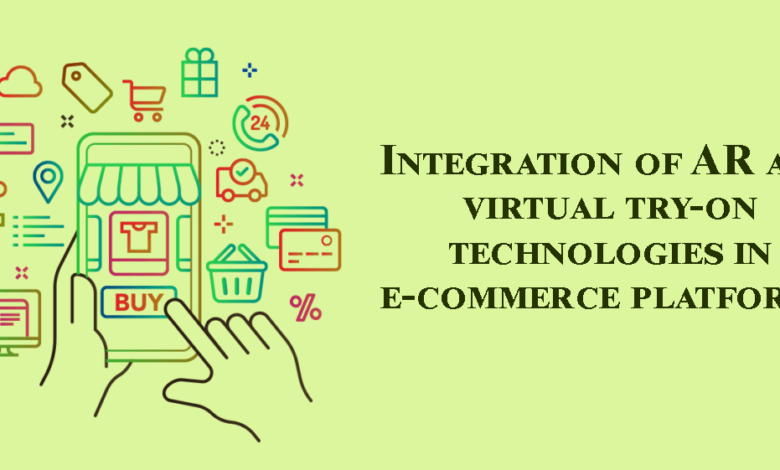Integration of AR and virtual try-on technologies in e-commerce platforms

Ecommerce has evolved remarkably in recent years and has become an important part of our lives. It started from a humble beginning and advanced to a colossal industry.
In the early days, online shopping was akin to a digital catalog, with limited choices and clunky interfaces. But as technological innovations surged forward, so did e-commerce. Websites became more user-friendly, allowing shoppers to navigate seamlessly.
Prestashop development companies played a crucial role in this evolution. They provided businesses with the tools to create beautiful, functional online stores. These companies harnessed the power of open-source software, allowing for customization and scalability previously unattainable.
As e-commerce platforms matured, so did the shopping experience. Features like secure payment gateways, intuitive search algorithms, and mobile responsiveness transformed the way we shop online. It’s no longer a simple transaction; it’s an immersive journey.
The growth of online marketplaces and the integration of AI-driven recommendations have made e-commerce an ecosystem of its own. Now, consumers can discover products tailored to their preferences with just a click.
Such an evolution driven by both technologies and Prestashop development companies has created a diverse, rich and incredibly convenient experience.
And this is just the beginning of what promises to be an even more exciting journey.
Understanding Augmented Reality (AR) and Virtual Try-On
AR, abbreviated as Augmented Reality, is a new magical way to enhance our real-world experiences. It overlays computer-generated elements into a view of the physical world. It’s like having a helpful sidekick, adding a layer of digital information to what we see.
Definition and Basics
At its core, AR blends real and digital worlds seamlessly. It relies on devices like smartphones or AR glasses to deliver this mixed reality. By using sensors, cameras, and advanced algorithms, AR recognizes our surroundings and inserts relevant digital content, creating an immersive experience.
Examples of AR in Everyday Life
AR isn’t limited to sci-fi fantasies. It’s all around us. Think about those Snapchat filters that give you puppy ears or funky glasses in real-time. That’s AR in action. And remember Pokémon GO? It’s another prime example of AR, where virtual Pokémon inhabit the real world through your smartphone’s camera.
Virtual Try-On: Revolutionizing the Shopping Experience
Virtual Try-On takes AR to a whole new level, especially in the world of e-commerce. Imagine trying on clothes, sunglasses, or makeup virtually before making a purchase. It’s like having a fitting room in your pocket.
Exploring Virtual Try-On Technology
This technology uses AR to superimpose products onto your image or environment, allowing you to see how they look before buying. It’s not just for fashion; it extends to furniture, jewelry, and more.
Benefits for Customers and Retailers
Customers gain confidence in their purchases, reducing returns. Retailers see increased engagement and conversion rates. AR and Virtual Try-On are shaping the future of shopping, making it more interactive, fun, and informed than ever before. Understanding Augmented Reality (AR) and Virtual Try-On
The Impact of AR and Virtual Try-On in E-commerce
In the ever-evolving landscape of e-commerce, the integration of AR and Virtual Try-On is nothing short of a game-changer. Here’s how it’s rewriting the rules and transforming the way we shop online:
Enhancing Customer Engagement: AR and Virtual Try-On create an interactive playground for shoppers. They can visualize products in their own space, turning shopping into a dynamic experience rather than a passive one.
Interactive Product Visualization: Customers can now check out products in an interactive 3D instead of static images. Customers can interact with them, which will increase the use-engagement virtually. Such a hand-on approach connects online and in-store shopping experiences.
Personalization and Customization: AR allows for personalized recommendations based on a customer’s preferences and browsing history. Virtual Try-On takes it a step further by letting customers see how a product fits their unique style and physique.
Reducing Return Rates: One of the most significant challenges in online shopping is the “fit” issue. Virtual Try-On tackles this problem head-on by enabling customers to virtually try on clothing and accessories. No more disappointment upon delivery.
Boosting Sales and Conversion Rates: When customers can visualize products more accurately, their confidence soars. This leads to a higher likelihood of completing the purchase. Additionally, data-driven recommendations based on Virtual Try-On sessions guide customers to products they’ll love.
In summary, the impact of AR and Virtual Try-On in e-commerce is profound. It’s making shopping more engaging, personalized, and efficient, while also addressing long-standing issues like fit concerns. The future of online shopping has never looked brighter.
Implementing AR and Virtual Try-On in E-commerce
When it comes to bringing AR and Virtual Try-On into your e-commerce game, there’s a lot more than meets the eye.
The Technical Aspect: It requires a solid foundation to implement cutting-edge technologies like augmented realty. It begins with the proper software and hardware to support such an advance technology.
Integrating AR Features into Your E-commerce Platform: Your e-commerce platform needs to be AR-ready. This means seamless integration of AR features, ensuring they work harmoniously with your existing setup.
Choosing the Right Virtual Try-On Solutions: Not all Virtual Try-On solutions are created equal. Selecting the one that aligns with your product range and customer base is crucial. Consider factors like compatibility and scalability.
User Experience Considerations: The key to success lies in creating a user experience that’s as smooth as silk. Your interfaces should be intuitive and user-friendly, making AR and Virtual Try-On accessible to all.
Seamless and User-Friendly Interfaces: Complicated interfaces can turn customers away. Keep it simple and intuitive to encourage interaction.
Mobile-Friendly Applications: Mobile is where the action is. Ensure your AR and Virtual Try-On solutions are mobile-friendly, allowing customers to engage on their smartphones and tablets effortlessly.
Measuring Success: To gauge the impact of AR and Virtual Try-On, track relevant metrics. Keep an eye on engagement rates, conversion numbers, and user feedback.
Metrics to Track AR and Virtual Try-On Effectiveness: Metrics like click-through rates, time spent on AR experiences, and conversion rates tell you how well these technologies are performing.
Gathering Customer Feedback for Improvement: Don’t forget the human touch. Customer feedback can provide invaluable insights for refining your AR and Virtual Try-On strategies.
Conclusion:
In the ever-evolving realm of e-commerce, the integration of cutting-edge technologies like augmented reality (AR) and virtual try-on marks a transformative chapter. These innovations, facilitated by Prestashop development companies and their peers, redefine the shopping experience. Meanwhile, virtual try-ons solve the age-old fit dilemma, enhancing customer confidence.
As the curtain falls on traditional online shopping, we welcome a new era. The impact of AR and virtual try-ons is undeniable, promising a future where consumers enjoy personalized, immersive shopping journeys. In this dynamic landscape, adaptation isn’t an option; it’s a necessity for retailers to thrive.





